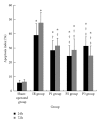Neuroprotective effect of phosphocreatine on focal cerebral ischemia-reperfusion injury
- PMID: 22505804
- PMCID: PMC3312326
- DOI: 10.1155/2012/168756
Neuroprotective effect of phosphocreatine on focal cerebral ischemia-reperfusion injury
Abstract
Phosphocreatine (PCr) is a natural compound, which can donate high-energy phosphate group to ADP to synthesize ATP, even in the absence of oxygen and glucose. At present, it is widely used in cardiac and renal ischemia-reperfusion (IR) disease. In this study, to examine the protective efficacy of PCr against cerebral IR, disodium creatine phosphate was injected intravenously into rats before focal cerebral IR. Intracranial pressure (ICP), neurological score, cerebral infarction volume, and apoptotic neurons were observed. Expression of caspase-3 and aquaporin-4 (AQP4) was analyzed. Compared with IR group, rats pretreated with PCr had better neurologic score, less infarction volume, fewer ultrastructural histopathologic changes, reduced apoptosis, and lower aquaporin-4 level. In conclusion, PCr is neuroprotective after transient focal cerebral IR injury. Such a protection might be associated with apoptosis regulating proteins.
Figures







References
-
- Konig M, Klotz M, Heuser L, et al. Perfusion CT in acute stroke: characterization of cerebral ischemia using parameter images of cerebral blood flow and their therapeutic relevance clinical experience. Electromedia. 1998;66:61–67.
-
- Wyss M, Kaddurah-Daouk R. Creatine and creatinine metabolism. Physiological Reviews. 2000;80(3):1107–1213. - PubMed
-
- Rawson ES, Venezia AC. Use of creatine in the elderly and evidence for effects on cognitive function in young and old. Amino Acids. 2011;40(5):1349–1362. - PubMed
-
- Luisa P, Aroldo C, Gian LL, Principato C, Gandolfo C, Balestrino M. Kinetics of creatine in blood and brain after intraperitoneal injection in the rat. Brain Research. 2003;974(1-2):37–42. - PubMed
-
- Balestrino M, Lensman M, Parodi M, et al. Role of creatine and phosphocreatine in neuronal protection from anoxic and ischemic damage. Amino Acids. 2002;23(1–3):221–229. - PubMed
Publication types
MeSH terms
Substances
LinkOut - more resources
Full Text Sources
Research Materials

